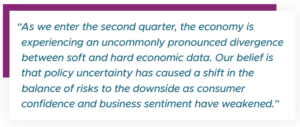Perspectives
Keep
Reading

Taxable Monthly Update March 2025
Taxable Bond | InsightOur Taxable Bond Team shares how key market developments in January 2025 are influencing their portfolio positioning, sector allocation, and outlook.
Read Article
Assessing Tariff Risks On Corporate Credit
Taxable Bond | InsightCorporate bonds may offer an attractive combination of downside protection and positive carry to navigate the current economic environment. Our team shares how active management can help calibrate exposure to the most vulnerable effects of tariffs.
Read Article
GW&K Taxable Monthly Update February 2025
Taxable Bond | InsightOur Taxable Bond Team shares how key market developments in February 2025 are influencing their portfolio positioning, sector allocation, and outlook.
Read ArticleThis Website Uses Cookies
We use cookies to improve your experience on our website. To accept cookies click Accept & Close, or continue browsing as normal. For more information or to learn how to opt out of cookies, please see our cookie policy.
Accept and CloseStay Updated & Informed with GW&K
GW&K's CIO and Portfolio Managers share their insights and opinions on the economy and market each quarter.
-
Latest Insight
How Reliant is the Municipal Market on Federal Funding?
Municipal Bond
Even amid recent volatility, municipal bonds continued to behave as you’d expect from one of the more stable corners of fixed income.
Download -
Latest Market Commentary
State Of The States 2025 — Poised For Fiscal Stability
Municipal Bond
Fiscal conditions across state governments remain healthy as the sector heads into 2025.
Read Article
Taxable Bond Market Commentary – 1Q 2025
The first quarter offered a reminder of how quickly market narratives can shift. The period began with continued optimism around the strength of the US economy, underpinned by a solid labor market, and resilient consumer. However, midway through the quarter, the emergence of softer economic data and fluctuating tariff policies drove market sentiment toward a heightened sense of apprehension around the growth and inflation outlook. Investors
sought the safe haven of fixed income, as the market quickly shifted its focus to recession fears and global trade tensions. Throughout this shift, the Fed held rates steady, as expected, while signaling a more cautious growth and worrisome inflation outlook. The market, though, remains even more bearish on the economy, pricing in three cuts by the end of 2025 versus the Fed projecting just two.
The Bloomberg Aggregate Bond Index delivered a solid 2.8% return in the first quarter, recovering most of the ground it lost in the fourth quarter. The market’s shift to a risk-off stance drove investors into bonds, pushing the belly of the curve lower. In January, the 10- year Treasury yield briefly hit 4.8%, its highest level since October 2023, before rallying 60 basis points to end the quarter 37 basis points lower. Similarly, the 2-year Treasury yield fell 36 basis points, leaving the 2s-to10s yield curve little changed. Ultra-short rates,
by contrast, held relatively steady during a bull flattening of the 3mos-to-10s yield curve, which ended the quarter back in negative territory, where it had been for the past two and a half years.
Positive returns in the corporate credit market masked the abrupt shift in sentiment. Investment grade and high-yield spreads rose by 14 and 60 basis points, respectively. Both segments delivered negative excess returns as their carry advantage was not enough to offset the impact of wider spreads. Driven by softer economic readings and concerns about tariff effects, lower-rated securities uniformly underperformed across the corporate credit market. CCC-rated securities highlighted the risk-off move as the only quality bucket to deliver a negative total return. Despite the more cautious risk outlook, many factors that have made the corporate bond sector appealing remain in place. Market dynamics are still healthy, with economic conditions supporting robust corporate credit fundamentals, and attractive all-in yields driving investor demand.
The securitized sector was not immune to the broader risk-off move as it underperformed comparable duration Treasuries. Growing concerns around potential changes to the Government Sponsored Enterprises’ (GSEs) regulatory framework and the risk of privatization led to negative excess returns for Agency MBS and overwhelmed the positive effects of a favorable technical environment and limited rate volatility. Within MBS, performance was mixed as lower coupon securities underperformed mid-to-higher coupon bonds, which delivered strong excess returns. Asset-backed securities (ABS) lagged, primarily due to weakness in the utility sector, which continues to face pressures related to California wildfires. In sympathy with growing macro uncertainty, consumer-facing ABS spreads also moved wider. Despite these challenges, we remain constructive on the securitized sector. MBS spreads are attractive relative to historical averages, while ABS finds support from strong underlying collateral performance and structural protections.
As we enter the second quarter, the economy is experiencing an uncommonly pronounced divergence between soft and hard economic data. Our belief is that policy uncertainty has caused a shift in the balance of risks to the downside as consumer confidence and business sentiment have weakened. Current US economic fundamentals remain sound on the back of a resilient labor market and rising incomes, but a consumer pull back would lead to slower growth ahead. That said, the Fed has conveyed a willingness to ease policy in the interest of pursuing its dual mandate, so any deterioration in fundamentals is likely to be brief and shallow.
Our duration stance is neutral, as the upward pressure of rising inflation expectations is offset by emerging evidence of some real growth concerns in the data. We believe rates should remain relatively rangebound until the market gains direction from either the hard or soft economic data, and further clarity around new trade and tariff policies is received.
Disclosures
This represents the views and opinions of GW&K Investment Management and does not constitute investment advice, nor should it be considered predictive of any future market performance. Data is from what we believe to be reliable sources, but it cannot be guaranteed. Opinions expressed are subject to change. Past performance is not indicative of future results.
Indexes are not subject to fees and expenses typically associated with managed accounts or investment funds. Investments cannot be made directly in an index. Index data has been obtained from third-party data providers that GW&K believes to be reliable, but GW&K does not guarantee its accuracy, completeness or timeliness. Third-party data providers make no warranties or representations relating to the accuracy, completeness or timeliness of the data they provide and are not liable for any damages relating to this data. The third-party data may not be further redistributed or used without the relevant third-party’s consent. Sources for index data include: Bloomberg, FactSet, ICE, FTSE Russell, MSCI and Standard & Poor’s.